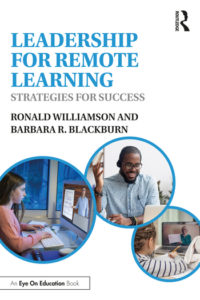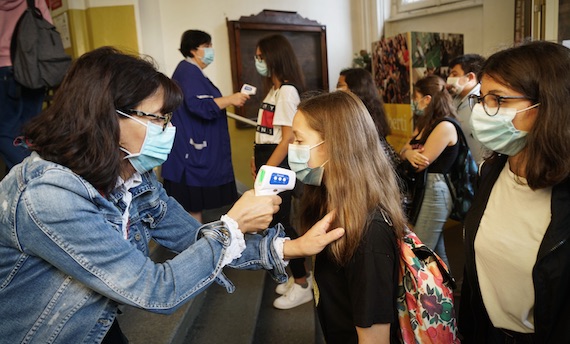9 Ways to Support Staff and Teachers Right Now
By Ronald Williamson and Barbara R. Blackburn
 This school year is unlike any in memory. Across the country educators find themselves trying to juggle the instructional and social-emotional needs of their students as well as needs of students’ families.
This school year is unlike any in memory. Across the country educators find themselves trying to juggle the instructional and social-emotional needs of their students as well as needs of students’ families.

A recent survey of educators by one Michigan university found the most common descriptor of the school year was “exhausting.”
Schools move in and out of remote learning based on local and state health protocols, and educators are whipsawed between face-to-face instruction and hybrid or remote learning models. In too many cases teachers must provide both – contributing to long days and less time for family, friends and their personal lives.
School leaders are often left to grapple with the impact of decisions made elsewhere and to support their teachers and staff in times of great uncertainty and unlimited ambiguity.
Providing Support During Remote Learning
Building a positive relationship with teachers is key to your success as a school leader. Although this is always true, it is even more important this school year.
Many of the informal ways we provide support and build relationships with teachers, such as dropping by a classroom during planning period or checking with a teacher when you see them in the hall, cannot take place in remote learning. An online meeting doesn’t substitute for the friendly banter of a staff meeting, social gathering or hall chat.
It’s important to recognize the challenges of remote work. Remote workers often experience social isolation, disconnected from one another and from their principal. They also lack access to information or resources, and in many cases are dealing with distractions from home like dealing with childcare or even having a location to do their work.
The challenges are real, but there are things you can do to support your employees while working remotely (Larson, Vroman & Makarius, 2020).
Nine Ways to Support Pandemic Teaching
Here are nine ways you can be supportive to your teachers and staff during this challenging school year.
►Clarify the “rules of engagement” – Talk with individual teachers about the frequency, means and ideal timing of communication. Be sensitive to the constraints of remote work and the need for employees to balance demands for child-care, and multiple work and learning schedules, with their own work. For example, at the end of the school day may not be the optimal time for an online supervisory meeting.
One school used videoconferencing for check-in’s and other meetings but agreed to use texting when something was urgent. Also be clear about expectations for sharing information among your teachers. Identify a time during the day when employees can reach you.
►Provide Lots of Information – Remote employees often feel isolated and that they lack information. That’s because the informal interaction that we take for granted in a physical school is missing in a virtual school. Provide regular updates even if you have little to update. Communication is one way to maintain connections among remote employees.
One principal in Oregon sends every employee a weekly COVID update. Parts of it are repetitious, including reminders of important safety protocols, but each week there are updates on action the school district is taking to support remote instruction, modify classrooms in preparation for the return of face-to-face instruction, and good news from across the district.
►Use Multiple Communication Tools – Mass emails to the entire faculty distributes information quickly but is insufficient. Become familiar with and use a variety of communication approaches. People are often more engaged and interactive when using video to talk about their work. Video also provides visual cues and reduces the sense of isolation. It’s far more personal than email or other written communication.
►Personalize Meetings and Assure Privacy – Be sure that every meeting is tailored to meet the needs of each individual teacher. Be respectful of teachers’ need for privacy. Always meet one on one and defer to the teacher regarding location and setting. Webcams can be incredibly intrusive, and whether it’s one’s personal office or one’s home, there may be things you don’t want others to observe.
►Encourage Setting Boundaries – Studies show that remote workers often spend more time working than when they are in a traditional setting. Monitor your teachers to assure they are maintaining work-life balance. Remote working does not mean responding to parents or students at all hours.
►Monitor Non-Verbal Behavior – In online meetings our tone and voice serve as proxies for some of the other non-verbal feedback we receive when we’re together, face to face. The inflection or pitch of the voice or even the frequency of comments can indicate that the employee is experiencing some anxiety. People have different levels of engagement in individual or team meetings. Be looking for changes in behavior. Is an employee less engaged than normal?
►Minimize Social Isolation – Loneliness and isolation are common complaints in remote work. Those informal connections mentioned earlier are missing. Many people build their own network and connect with friends and colleagues. But that often doesn’t substitute for the interaction at work. Some leaders organize something called the “virtual water cooler” where their employees can meet online in a video conference site to just talk and catch up on each other’s lives. The meetings are always voluntary.
The key is to provide a quick update, under a minute, and then to ask something like “what do you have planned for the week-end?” or “what’s going on with your . . .” One principal had a virtual pizza party by having pizza delivered to every participant at the beginning of a videoconference. They chatted about non-work topics while they enjoyed pizza. While these events sound “forced,” they actually help to reduce feelings of isolation.
►Offer Encouragement and Emotional Support – The research on emotional intelligence and emotional contagion says that employees look for cues about how to react to changes like moving in and out of remote learning. If you communicate stress, that will “trickle-down” to your employees (Goleman, 2005).
It is important to acknowledge the stress and anxiety that come from abrupt transitions like suddenly moving into remote learning. Listen to your teachers and staff and empathize with their concerns. Listen carefully and let what they have to say be the focus of the conversation. Follow their lead when they identify challenges and be willing to help them problem solve and resolve an issue. Also provide affirmation and express confidence in your teaching team.
►Model Optimism and Drain Fear – Teachers and other employees pay attention to the leader’s behavior. When you talk, be sure to remain optimistic, provide examples of success, and as we mentioned, always offer support. Functioning in a challenging teaching environment, often with some health risks for students and adults, can create fear and anxiety. Your job is to drain away that fear and be encouraging and supportive.
Final Thoughts
A major responsibility of school leaders is to support their teachers working in this uncertain environment. Building and strengthening relationships and supporting and coaching teachers in a variety of ways is essential. Most importantly, leaders should recognize that each teacher is an individual, and the type of support you provide needs to vary to address those differences.
References
Blackburn, B. (2020). Rigor in the remote learning classroom: Instructional tips and strategies. Routledge.
Goleman, D. (2005). Emotional intelligence: Why it can matter more than IQ. Bantam Books.
Larson, B, Vroman, S. & Makarius, E. (2020). A guide to managing your (newly) remote workers. Harvard Business Review. Retrieved from https://hbr.org/2020/03/a-guide-to-managing-your-newly-remote-workers
Williamson, R. & Blackburn, B. (2020). 7 strategies for improving your school. Routledge.

Barbara R. Blackburn, a “Top 30 Global Guru in Education,” is a bestselling author and sought-after consultant. She was an award-winning professor at Winthrop University and has taught students of all ages. In addition to speaking at conferences worldwide, she regularly presents virtual and on-site workshops for teachers and administrators. Barbara is the author of 2020’s Rigor in the Remote Learning Classroom: Instructional Tips and Strategies from Routledge.
































